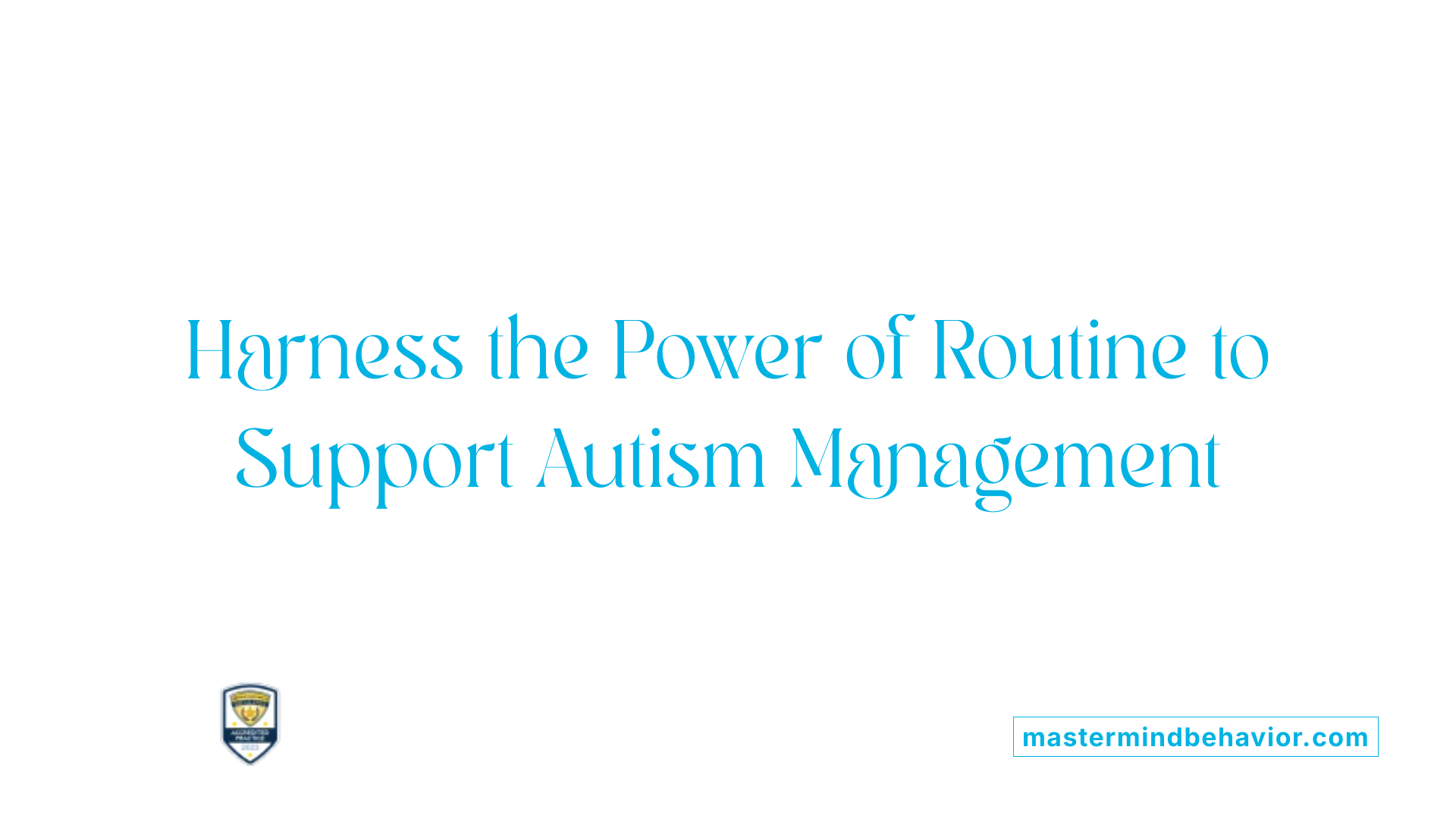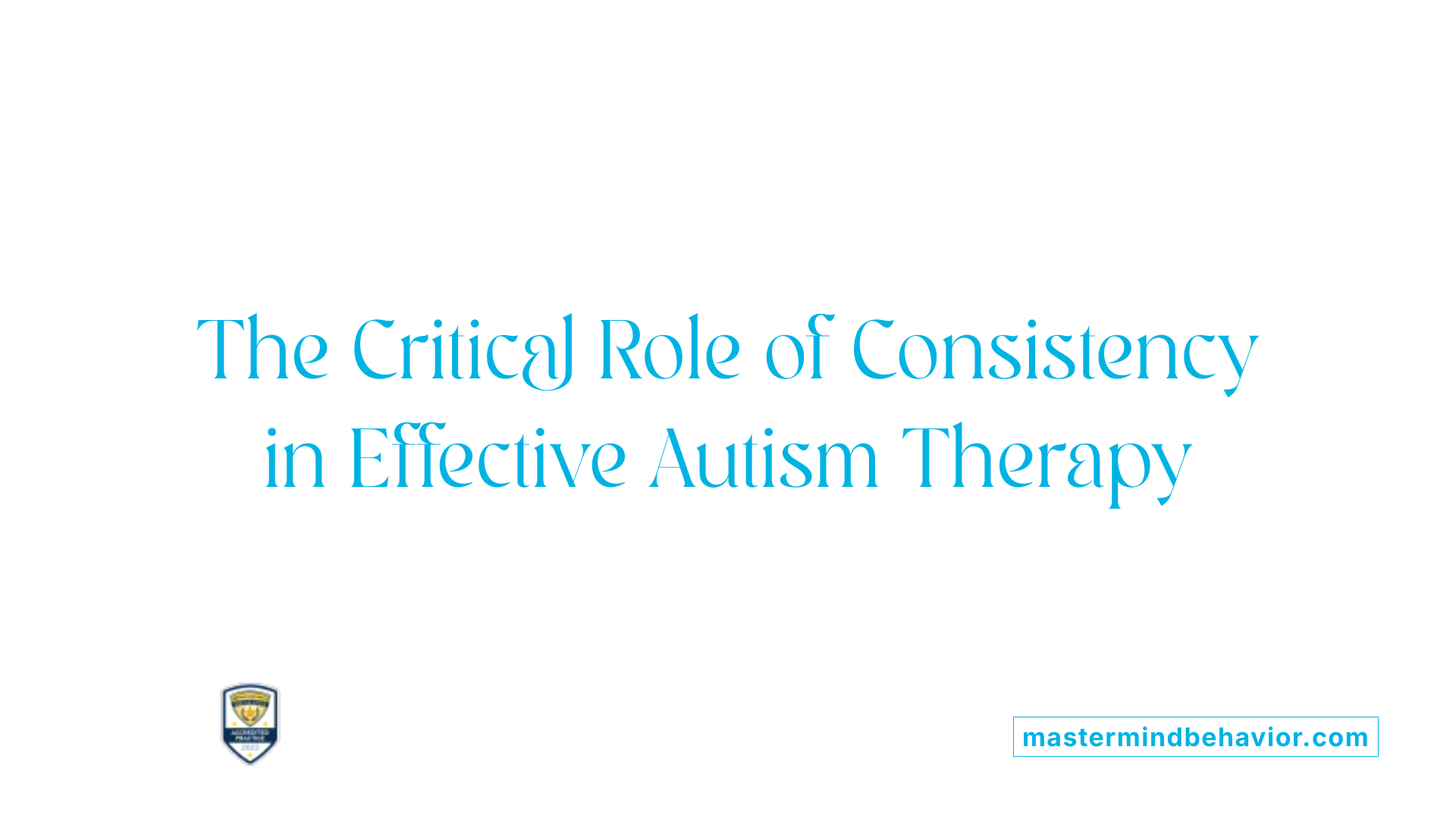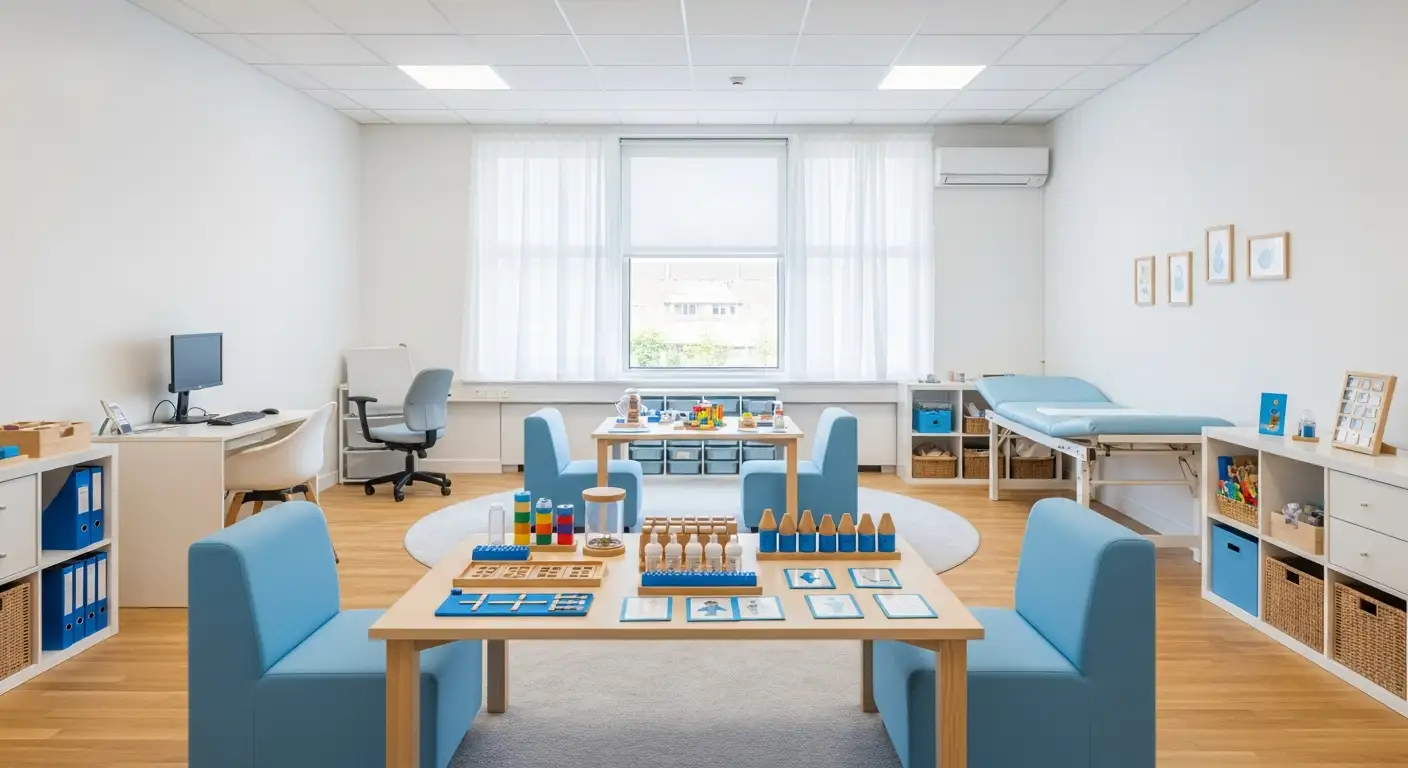The Importance of Consistency in Behavior Therapy for Children with Autism

Why Consistency Is Key in Supporting Children with Autism
For children with autism, predictability and routine form the cornerstone of effective behavior management and skill development. Consistency in therapy, environment, and caregiver responses creates a stable framework that fosters learning, reduces anxiety, and promotes independence. This article explores how maintaining uniformity in behavioral interventions, routines, and communication strategies not only enhances therapeutic outcomes but also supports the overall well-being of children with autism.
Understanding the Significance of Consistency in Behavior Guidance

Why is consistency important when guiding children's behavior?
Consistency plays a crucial role in guiding children’s behavior, especially for children with autism or other developmental needs. It helps establish clear boundaries and expectations, which are essential for children to feel safe and secure. When routines and responses are predictable, children are better able to manage their emotions and behaviors, leading to less confusion and anxiety.
Using consistent consequences and reinforcement strategies teaches children what is acceptable and helps them learn self-control and responsibility. For instance, if a child receives the same gentle correction for a disruptive behavior consistently, they understand what behavior is expected.
Furthermore, consistency among caregivers such as parents, teachers, and therapists prevents mixed messages. When everyone responds in a similar manner, children develop a stable understanding of rules, which reinforces their learning.
Implementing small routines that are followed each day makes rules more manageable and reinforces positive behavior over time. Being consistent in responses supports children's overall development of discipline and adaptive skills, helping them navigate social and everyday situations more effectively.
The Power of Routine and Predictability in Autism Management

Can routines and predictability benefit children with autism?
Routines and predictability play a vital role in supporting children with autism. When daily activities follow consistent patterns, children feel more secure and are better able to regulate their emotions. Familiar routines, such as specific morning or bedtime schedules, reduce anxiety by providing a sense of control over their environment.
Structured schedules make it easier for children to manage transitions from one activity to another, decreasing stress and behavioral challenges. These routines also foster independence, allowing children to perform tasks with minimal assistance as they become accustomed to predictable steps.
Sensory regulation is another benefit; familiar activities and routines help children manage sensory input and avoid overload. For example, consistent use of visual supports and communication tools reinforces understanding and self-expression.
While routines are invaluable, they should be flexible enough to adapt when necessary. Rigid routines that cause distress if disrupted can be counterproductive, so a balance must be maintained. If routines become obsessive or lead to anxiety when broken, support from caregivers or therapists is important to help children cope.
Overall, implementing predictability through routines can significantly enhance learning, emotional well-being, and social participation for children with autism.
| Benefits of Routines | Description | Additional Details |
|---|---|---|
| Anxiety Reduction | Familiarity lowers stress | Helps children feel secure and calm |
| Skill Development | Consistent activities promote learning | Facilitates skill transfer across settings |
| Emotional Regulation | Routine aids in managing energy | Supports calming and stimming behaviors |
| Transition Management | Structured schedules ease change | Reduces resistance and meltdown risks |
| Social Engagement | Predictability fosters participation | Builds confidence in social settings |
Incorporating routines requires collaboration among caregivers, educators, and therapists. Using visual schedules, consistent responses, and predictable activities enhances the effectiveness of routines.
Supporting children with autism through well-designed routines not only comforts them but also empowers their growth and independence in daily life.
Why Consistency Is Critical in Autism Behavior Therapy

Why is consistency critical in autism behavior therapy?
Consistency plays a vital role in supporting individuals with autism through therapy programs like Applied Behavior Analysis (ABA). When therapeutic techniques are applied uniformly across different settings and caregivers, children can better retain and build upon the skills they learn.
A consistent approach helps prevent regression, a common concern for children with autism. By reinforcing skills regularly, children become more confident and capable of applying their knowledge in daily life.
Moreover, routine and uniformity facilitate the generalization of skills across various environments—such as home, school, and community—making these skills more practical and functional.
Ongoing, individualized ABA support ensures that therapy remains relevant to the child's development. Consistency in delivery allows therapists to accurately monitor progress, collect useful data, and fine-tune interventions effectively.
This stable approach also helps children navigate behavioral challenges brought on by routine changes, like holidays or school transitions. When children understand what to expect, their anxiety levels decrease, making them more receptive to learning.
In summary, consistency creates a safe, predictable environment that fosters trust and emotional security. It underpins the child's ability to learn, adapt, and thrive by reducing confusion and promoting a steady path of growth.
How Consistency Fuels Skill Development and Behavioral Progress

How does consistency in ABA therapy influence skill development?
Maintaining consistency in ABA therapy is essential for promoting effective learning and behavior change in children with autism. When therapy techniques such as positive reinforcement and prompting are applied uniformly across sessions and settings, children can better understand expectations and internalize new skills. Consistent use of these methods supports the generalization of learned behaviors from therapy to home and school environments.
In addition, structured routines create a predictable environment where children feel safe and are more likely to participate actively in learning. This predictability reduces anxiety, enabling children to focus on acquiring new skills with fewer distractions or fears.
Behavioral progress relies heavily on ongoing data collection. Tracking responses allows therapists and caregivers to evaluate what strategies work best and make necessary adjustments. Collaborative efforts among parents, teachers, and therapists ensure that reinforcement and prompts are applied similarly across all settings, strengthening consistency.
Moreover, using engaging, play-based activities within a structured routine fosters motivation and makes learning enjoyable. As a result, children are more inclined to practice new skills repeatedly, leading to greater mastery.
In summary, unwavering consistency in applying evidence-based techniques accelerates skill acquisition, supports generalization across environments, and leads to more meaningful, long-lasting progress.
Implementing and Sustaining Consistency in Practice
How can standardized protocols and checklists support consistency?
Using standardized protocols and checklists helps create a uniform approach across different settings and caregivers. They ensure that the same teaching techniques, reinforcement strategies, and behavioral principles are applied consistently. This reduces confusion and helps children with autism predict what to expect, fostering a sense of safety and stability.
Why is building a consistent team of therapists important?
A consistent team of therapists who are familiar with the child's needs provides predictable and cohesive support. When therapists follow the same strategies and communicate regularly, children experience fewer mixed messages. This continuity enhances learning, promotes generalization of skills, and increases trust and emotional security.
How does applying similar behavioral techniques at home and school improve outcomes?
Applying consistent behavioral techniques, such as positive reinforcement and visual supports, across home and school environments reinforces learning. It helps children understand expectations and reduces behavioral challenges. Consistency in applying these techniques ensures that children receive clear, predictable guidance wherever they are.
What role does family involvement play in supporting routines and visual supports?
Supporting family involvement with predictable routines and visual supports is essential for reinforcing skills outside of therapy. Visual schedules help children understand daily routines, reducing anxiety and improving cooperation. When families use similar cues and responses, children adapt more easily across different environments.
How can ensuring consistency in reinforcement and responses benefit children?
Consistency in reinforcement and responses helps children learn rules and understand the consequences of their actions. It promotes behavioral improvements and encourages the development of independence. Using similar praise, rewards, and responses across settings fosters a stable learning environment, making it easier for children to acquire and maintain new skills.
The Broader Benefits of Consistent Approaches in Autism Support

Reducing anxiety and promoting emotional regulation
Maintaining consistent routines and environments plays a vital role in reducing anxiety for individuals with autism. When daily schedules, expectations, and responses remain stable, children feel more secure and less overwhelmed by changes. Creating a predictable setting helps them manage transitions smoothly, which supports emotional regulation and overall well-being.
Supporting independence in daily tasks
Consistency in routines and expectations encourages independence among individuals with autism. When tasks such as dressing, eating, or using communication tools are structured in familiar ways, children can perform these activities with minimal assistance. Repeating these routines fosters confidence and self-reliance, empowering them to handle daily challenges more effectively.
Facilitating skill transfer across environments
Applying consistent teaching methods and behavioral strategies across home, therapy, and school settings helps children generalize skills beyond specific sessions. For example, using visual schedules and positive reinforcement techniques consistently teaches children appropriate behaviors that they can demonstrate in different settings, increasing their adaptability and functional independence.
Building trust and emotional security with caregivers
Consistent responses from caregivers and therapists foster trust and a sense of security. When children know what to expect and see familiar cues and reinforcement, they develop strong emotional bonds and feel safe exploring new skills. This emotional stability encourages more active participation in learning and social interactions.
Consistency in autism support not only helps reduce anxiety but also creates a safe and nurturing environment that promotes growth, independence, and emotional health.
Building a Future with Predictability and Trust
In conclusion, consistency in behavior therapy for children with autism is integral to fostering meaningful progress. It helps consolidate learning, eases transitions, and reduces anxiety, creating a safe and supportive environment for developmental growth. By implementing structured routines, uniform communication strategies, and collaborative efforts among caregivers and therapists, we pave the way for children to gain independence, social skills, and emotional resilience. Emphasizing consistent practices across all settings will continue to be the key to unlocking each child's potential.
References
- Importance of Consistency in Autism - Golden Care Therapy
- The Importance of Consistency in Autism Therapy
- The Importance of Sticking to Consistent ABA Therapy
- The Importance of Consistency in ABA Therapy
- The Importance of Consistency in ABA Therapy: How Routine Builds ...
- The Role of Play in ABA Therapy: Making Therapy Fun
- How ABA Therapy Can Improve Communication Skills in Children
- Preference for order, predictability or routine - National Autistic Society
- What is autism - National Autistic Society
Recent articles

How To Integrate ABA Strategies During Mealtime And Snack Time
Practical ABA Techniques to Enhance Mealtime Experiences for Children with Autism

ABA Therapy To Support Emotional Expression In Young Children
Harnessing ABA Therapy to Enhance Emotional Expression in Early Childhood Autism

Understanding Functional Communication Training (FCT) In ABA Therapy
Unlocking Communication: How Functional Communication Training Transforms ABA Therapy

ABA Therapy To Reduce Argumentative Behavior In Children
Transforming Challenging Behaviors: The Role of ABA in Autism Care

Teaching Independent Decision Making Through ABA
Unlocking Autonomy: The Role of ABA in Fostering Independent Decision Making

The Role Of ABA Therapy In Supporting Children With Social Challenges
Unlocking Social Potential: How ABA Therapy Empowers Children with Autism



